The Woman's Building (Chicago)
The Woman's Building was designed and built for the World's Columbian Exposition held in Chicago in 1893.[1] It had exhibition space as well as an assembly room, a library, and a Hall of Honor. The History of the World's Fair states, "It will be a long time before such an aggregation of woman's work, as may now be seen in the Woman's Building, can be gathered from all parts of the world again."[2]
_designed_by_Sophia_Hayden.png)
Origins
Beginning in 1889, activist women in Chicago lobbied to make their city the site of the world's fair of 1892. They also petitioned for an official place for women in the planning and exhibitions at the fair. Led by Emma Gilson Wallace, they suggested forming a "Women's Department for the Fair".[3] These activists came from various women's organizations involved in philanthropy, education, and suffrage.[4]
The Quatro-Centennial Committee of the Senate (i.e. commemorating the 400th anniversary of Columbus's first voyage to the New World) approved the Fair Bill naming Chicago as the site. When the bill was sent to the House of Representatives, William McKendree Springer attached an amendment to create a Board of Lady Managers. The House accepted the bill and in 1890 President Benjamin Harrison signed the bill into law.[5]
The Board appointments, made by the National Commission, numbered 117, including two Lady Managers from each state, territory and the District of Columbia, as well as members-at-large.[6] Among their duties related to the Fair, the Lady Managers were in charge of the plans for the Women's Hall.
Board of Lady Managers
.jpg)
Prominent Officials of the Board of Lady Managers[7]
- Mrs. Potter Palmer – President
- Mrs. Susan G. Cook – Secretary
- Mrs. V.C. Meredith – Vice Chairman Executive Committee
- Mrs. Russell B. Harrington – Vice-President at Large
- Mrs. John A. Logan – Vice-Chairman Committee on Ceremonies
Vice-Presidents of the Board of Lady Managers[8]
- Mrs. Ralph Trautman – First Vice-President
- Mrs. Edwin C. Burleigh – Second Vice-President
- Mrs. Charles Pierce – Third Vice-President
- Miss K.L. Minor – Fourth Vice-President
- Mrs. Beriah Wilkins – Fifth Vice-President
- Mrs. Susan R. Ashley – Sixth Vice-President
- Mrs. Flora Beall Ginty – Seventh Vice-President
- Mrs. Margaret Blaine Salisbury – Eighth Vice-President
Resident Members of the Board of Lady Managers[9]
- Mrs. Potter Palmer
- Mrs. Solomon Thacher, Jr.
- Mrs. L. Brace Shattuck
- Mrs. James A. Mulligan
- Dr. Frances Dickenson
- Mrs. M.R.M. Wallace
- Mrs. Leander Stone
- Mrs. James R. Doolittle, Jr.
- Mrs. Matilda B. Carse
Building
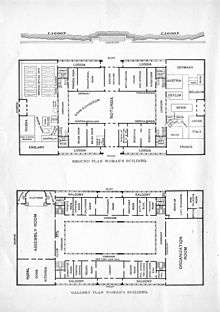
14 women architects submitted designs for the Woman's Building. The Board of Architects selected Sophia Hayden's design.[10] Alice Rideout was chosen as the official sculptor for the Woman's Building. She created the exterior sculpture groups and the pediment.[11] Enid Yandell designed and created the caryatid that supported the roof garden.[12] Candace Wheeler supervised the interior decorations.[13]
Interior decoration included murals painted by Mary Fairchild MacMonnies Low (Primitive Woman) and Mary Cassatt (Modern Woman). Cassatt was asked to paint a 58 x 12 foot mural for the north tympanum over the entrance to the Gallery of Honor, showcasing the advancement of women throughout history, called Modern Woman. Four panels in the Hall of Honor were painted by Lucia Fairchild Fuller, Amanda Brewster Sewell, Rosina Emmet Sherwood and Lydia Field Emmet.[14] The British sculptor Ellen Mary Rope contributed a bas relief, depicting ‘Hope, Charity, Faith and Heavenly Wisdom’, which found a later home in the dining room of the first Ladies' Residential Chambers in London, a project of cousins Rhoda and Agnes Garrett.[15] The library ceiling mural was painted by Dora Wheeler Keith.[13]
Exhibits
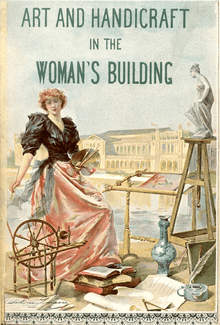
The Woman's Building contained exhibits of works by women across a variety of fields from fine art, applied art, literature and music, to science, and home economics. There were also exhibits about women in American History and other cultures and places in the world.[16]
Annexed to the Woman's Building was the Children's Building which exhibited American 19th century best practices for child-rearing and education.[17]
Legacy
Yandell co-wrote a semi-autobiographical account of her involvement in planning the fair, Three Girls in a Flat (1892).[18]
The exhibits at the Woman's building inspired Danish noblewoman, Sophie Oxholm, to organize a women's exhibition in Copenhagen, eventually resulting in the 1895 Copenhagen Women's Exhibition.[19]
Buildings at world's fairs are often demolished when the event ends, and finding another home for them is rarely practical. (The exception was The Crystal Palace after the Great Exhibition of 1851.) The Woman's Building was destroyed as part of the general demolition after the Fair.[20] Sadly, after the exposition, Cassatt's mural and many other artworks by many women were placed in storage and subsequently lost.[21]
Eighty years later, the Woman's Building had been almost lost to history. With the flourishing of second-wave feminism, women went searching for what had gone before. Feminist artist Judy Chicago and her team of students, in the midst of creating The Dinner Party, discovered a copy of the Woman's Building catalog in a second-hand bookstore. When the Los Angeles Woman's Building was opened in 1973, the founders decided to name the organization after the 1893 Woman's Building.[22]
Gallery
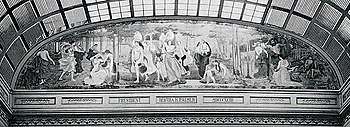 Mary Fairchild MacMonnies - Primitive Woman - Decoration for the Woman's Building at the World's Columbian Exposition 1893
Mary Fairchild MacMonnies - Primitive Woman - Decoration for the Woman's Building at the World's Columbian Exposition 1893 The Woman's Building, World's Columbian Exposition, 1893
The Woman's Building, World's Columbian Exposition, 1893 Woman'S Building — Official Views Of The World's Columbian Exposition — 45
Woman'S Building — Official Views Of The World's Columbian Exposition — 45_(14594058918).jpg) Hide and Seek. Sculptural Group in front of the Woman's Building
Hide and Seek. Sculptural Group in front of the Woman's Building_(14594062299).jpg) Part of the French Exhibit at the Woman's Building
Part of the French Exhibit at the Woman's Building View from Balcony of Woman's Building, William Henry Jackson, 1893
View from Balcony of Woman's Building, William Henry Jackson, 1893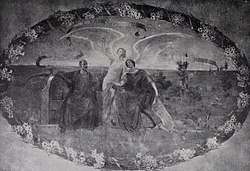 Library Ceiling Mural by Dora Wheeler Keith
Library Ceiling Mural by Dora Wheeler Keith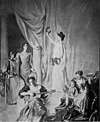 mural The Republic's Welcome to Her Daughters by Rosina Emmet Sherwood
mural The Republic's Welcome to Her Daughters by Rosina Emmet Sherwood
See also
- List of women artists exhibited at the 1893 World's Columbian Exposition
- White Rabbits (sculptors), a group of women who created statues for the Horticultural Building
- World's Congress of Representative Women, a week-long convention for the voicing of women's concerns, held at the Fair in May 1893
- Women's Building (disambiguation), other structures with a similar name
References
- Corn, Wanda M.; with contributions by Charlene G.; Garfinkel, Charlene G.; Madsen, Annelise K. (2010). Women building history: public art of the 1893 Columbian Exposition. Berkeley, Calif.: University of California Press. ISBN 0520241118.
- Truman, Benjamin Cummings (1893). History of the World's Fair : being a complete description of the Columbian Exposition from its inception. Philadelphia, Pa.: H.W. Kelley. p. 192.
- Weimann, Jeanne Madeline (1981). The Fair Women: the story of the Woman's Building World's Columbian Exposition Chicago 1893. Chicago: Academy Chicago. pp. 26-31. ISBN 0915864673.
- Weimann, Jeanne Madeline (1981). The Fair Women: the story of the Woman's Building World's Columbian Exposition Chicago 1893. Chicago: Academy Chicago. pp. 27. ISBN 0915864673.
- Weimann, Jeanne Madeline (1981). The Fair Women: the story of the Woman's Building World's Columbian Exposition Chicago 1893. Chicago: Academy Chicago. pp. 32-33. ISBN 0915864673.
- Weimann, Jeanne Madeline (1981). The Fair Women: the story of the Woman's Building World's Columbian Exposition Chicago 1893. Chicago: Academy Chicago. pp. 40-42. ISBN 0915864673.
- Elliott, Maud Howe (1894). Art and Handicraft in the Woman's Building of the World's Columbian Exposition Chicago, 1983. Chicago and New York: Rand McNally & Company. p. 14.
- Elliott, Maud Howe (1894). Art and Handicraft in the Woman's Building of the World's Columbian Exposition Chicago, 1983. Chicago and New York: Rand McNally & Company. p. 15.
- Weimann, Jeanne Madeline (1981). The Fair Women: the story of the Woman's Building World's Columbian Exposition Chicago 1893. Chicago: Academy Chicago. pp. 41. ISBN 0915864673.
- Ralph, Julian (1892). Chicago at the World's Fair. New York: Harper & Brothers Publishers. p. 162.
- Weimann, Jeanne Madeline (1981). The Fair Women: the story of the Woman's Building World's Columbian Exposition Chicago 1893. Chicago: Academy Chicago. pp. 167-175. ISBN 0915864673.
- Weimann, Jeanne Madeline (1981). The Fair Women: the story of the Woman's Building World's Columbian Exposition Chicago 1893. Chicago: Academy Chicago. pp. 159. ISBN 0915864673.
- Nichols, K. L. "Women's Public Arts & Architecture: 1893 Exposition". Women's Art at the World's Columbian Fair & Exposition, Chicago 1893. Retrieved 6 January 2019.
- Elliott, Maud Howe (1894). Art and Handicraft in the Woman's Building of the World's Columbian Exposition Chicago, 1983. Chicago and New York: Rand McNally & Company. p. 43-47.
- "Spirited Women of Gower Street: The Garretts and their Circle" (PDF). Retrieved 12 July 2018.
- Elliott, Maud Howe (1894). Art and Handicraft in the Woman's Building of the World's Columbian Exposition Chicago, 1983. Chicago and New York: Rand McNally & Company. p. 7.
- Elliott, Maud Howe (1894). Art and Handicraft in the Woman's Building of the World's Columbian Exposition Chicago, 1983. Chicago and New York: Rand McNally & Company. p. 189-194.
- Yandell, Enid; Hayes, Laura. "Three Girls in A Flat". A Celebration of Women Writers. Penn Libraries. Retrieved 9 March 2017.
- "Kvindernes Udstilling 1895". Emma Gad (in Danish). 30 June 2012. Retrieved 27 August 2018.
- Weimann, Jeanne Madeline (1981). The Fair Women: the story of the Woman's Building World's Columbian Exposition Chicago 1893. Chicago: Academy Chicago. pp. 593. ISBN 0915864673.
- Michalska, Magda. "Mary Cassatt's Feminist Mural Which Has Gone Lost". DailyArt Magazine. DailyArtMagazine.com. Retrieved 6 July 2018.
- "Celebrating The Woman's Building on International Women's Day". Otis College of Art and Design. Otis College of Art and Design. Retrieved 6 July 2018.
External links
- Digitized version of World's Columbian Exposition, 1893: Official catalogue: pt. XIV, woman's building by World's Columbian Exposition (1893 : Chicago, Ill.)
- Digitized version of Art and Handicraft in the Woman's Building of the World's Columbian Exposition, Chicago, 1893
- Scans of illustrations from 'Art and Handicraft in the Woman's Building of the World's Columbian Exposition, Chicago, 1893'
- The Women's Pavilion by By Anna Burrows
- The Book of the Fair:Chapter the Eleventh: Woman's Department